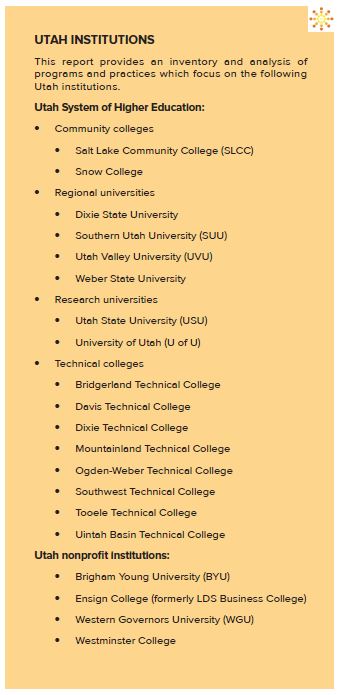Beating the Odds: Post-Secondary Success for Adult, First-Generation and Lower-Income Students explores various means of promoting both student retention and completion of certificates and degrees. It focuses on subsets of students who have been less likely to attain higher levels of education and receive the benefits of that attainment.

- Utah’s population is changing. If the state’s post-secondary educational institutions do not respond to those changes, tens of thousands of Utahns may miss out on educational advancement in the coming decades.
- Engaging and re-engaging with adult learners requires a specific set of strategies, such as offering robust child-care services, offering a wider range of online opportunities and providing class credit that is based upon pre-existing experience and course competencies.
- First-generation students – those whose parents have not completed college themselves – can struggle with some of the post-secondary familial advantages that many take for granted. UVU’s “I am First” and USU’s Aggie First Scholars programs are examples of support-programs that provide a useful bridge for this population.
- In Utah, the state’s contribution to need-based financial aid had been virtually nonexistent; that changed to a certain extent with the Utah Promise Scholarship in 2019 – though funding is limited. Based on SLCC and Weber State programs, the state scholarship provides lower-income student with the financial supports they might need, with remaining financial gaps being filled with the help of small emergency grants, and the U of U’s novel approach of using income-share agreements.
- Utah’s open-enrollment institutions have a particular focus on ensuring that students are prepared for college-level courses. This can include new approaches to engaging and assisting students who need to take remedial courses, but doing so in a way that encourages forward progress. Preparation can also take the form of “Higher Ed 101” courses that are designed to help underprepared students succeed. For example, is Dixie State’s Trailblazer Connections course is essentially Higher Ed 101 for all new freshman, and the university has a Study Skills and Student Success class that combines Trailblazer support with study skills for students who are enrolled in remedial courses.
- Prior learning assessments that draw on students’ experiences and competency-based educational options can make completing education after high school seem more tenable.
- Guidance on particular paths toward post-secondary education completion can help students narrow their focus in a way that keeps them from taking credits that increase the overall cost and lengthen time to completing their degrees.
- Wraparound services ranging from child-care programs to mental health services can be costly, but can often make the difference for continuing and completing education.
- Institutions are working to improve their advising. One newer approach is to more carefully track students, approaching them when institutions believe that the students might need help, instead of expecting the students to reach out with their needs.
- Student data analytics support all of the services described in this report. Examining the return on investment for post-secondary programs can help to ensure that governmental support and tuition is used in the best way possible to meet students’ educational goals.
Beating the Odds is the first installment in Utah Foundation’s Utah Post-Secondary Educational Attainment Series.

